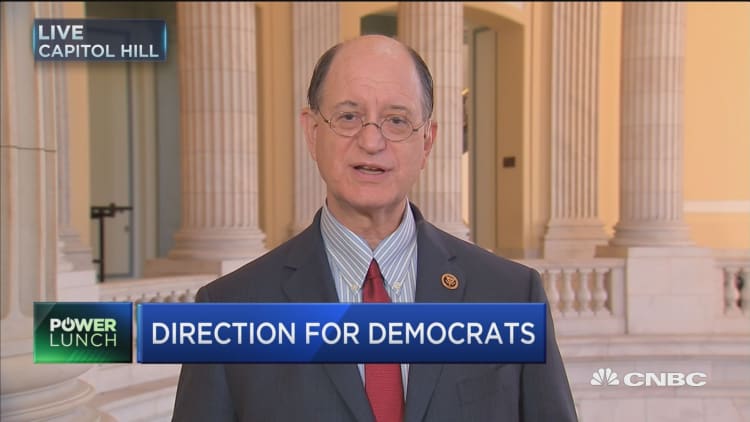
Opening more federal lands and waters to oil and gas drilling is a pillar of President-elect Donald Trump's plan to make the United States energy independent, but he probably won't see the results while he's in office.
In many cases, oil and gas would not start flowing from government-administered territory until after Trump wrapped up his time in office — even if he were to win a second term.
Trump has vowed to streamline permits to drill on federal land — a process that already started under President Barack Obama — but challenges would prevent quick and significant production from government land. Those include the years-long process of starting offshore projects, local and state opposition to drilling, and uncertainty over the path of currently depressed oil prices.
Market forces have far more influence on overall drilling activity than government policy, so it's questionable to draw a direct link between a president's views and output on nonfederal lands. For example, oil and gas production surged by 4 million barrels a day during Obama's first seven years in office, even though many oilmen consider him no friend to the industry.
But the White House can attempt to boost activity on government land, and there are three areas where oil and gas production is prohibited or limited: the waters of the U.S. Outer Continental Shelf, Alaska's Arctic National Wildlife Refuge and parts of the Lower 48 states.
Most oil production on federal territory comes from offshore drilling in the central and western Gulf of Mexico. There are smaller reserves of oil and gas off the East and West coasts and in the Arctic waters north of Alaska.
Drilling in much of these waters was prohibited until 2008, when Congress let its 26-year ban expire and President George W. Bush ended an executive branch's block first imposed by his father, George H.W. Bush.
Developing large offshore fields takes a minimum of seven years and can take more than a decade, according to Imran Khan, senior manager of the deepwater Gulf of Mexico team at research firm Wood Mackenzie. The industry would also need to build offshore processing facilities, which cost at least $1.5 billion in areas where that infrastructure does not already exist.
Building that infrastructure would generate significant economic activity and jobs, but there is little will to invest that kind of money right now. Even in the Gulf of Mexico, where infrastructure is plentiful, there is not much new exploratory drilling because oil prices are too low to justify the spending. Companies are instead conserving cash as they ride out an oil price bust entering its third year.
Those firms likely want to see prices not only rise to $55 a barrel, but stay above that level for 12 to 18 months before they approve more spending on deepwater exploration, Khan said. The U.S. Energy Information Administration sees benchmark West Texas Intermediate crude averaging $57 a barrel in 2018.
"At the end of the day, oil price is really what dictates the strategy and the planning in the boardrooms," he said.
U.S. Outer Continental Shelf
Companies could certainly buy new offshore leases and sit on them until prices recover, but preparing new blocks for auction would itself take years.
The Bureau of Ocean Energy Management offers leases in federal offshore waters as part of five-year plans. On Friday, the BOEM released its 2017 to 2022 schedule, which included 10 blocks in the Gulf of Mexico and one in Alaska's Cook Inlet, but none in Pacific, Atlantic or Arctic waters.
The Trump administration could revise the plan, but the bureau would have to develop a new five-year plan, which typically takes two to three years, according to Connie Gillette, the agency's deputy chief of public affairs.
It's also uncertain whether oil and gas companies would bite. Blocks recently offered in the undeveloped eastern Gulf of Mexico did not attract any bids, and oil majors have pulled out of Alaska's Chukchi Sea because the risks outweigh the opportunity, especially in today's price environment.
If history is any guide, efforts to open blocks in the Atlantic and Pacific could get wrapped up in challenges from states and municipalities that don't want drilling off their shores.
The federal government spent $1.5 billion to compensate drillers whose offshore leases were canceled due to local and state opposition in California, North Carolina, Florida and Alaska, according to a 2012 Congressional Budget Office review. The CBO said there are two dozen localities in California alone that have put up barriers to building the onshore facilities necessary to bring offshore oil and gas to market.
"Off the Santa Barbara coast is a good example of where we are not going to allow drilling," Rep. Brad Sherman, D-Calif., told CNBC's "Power Lunch" on Friday.

Localities are not the only source of opposition. Offshore drilling in the South Atlantic drew challenges earlier this year from the Pentagon, which said it would interfere with military maneuvers and missile testing.
The Arctic National Wildlife Refuge in Alaska's remote northeast is another area that has seen fierce opposition to drilling. Congressional Republicans have sought to allow oil and gas development there, and they could try again during Trump's presidency.
Bringing new projects online in Alaska's remote North Slope takes roughly five to seven years because conditions prevent development there throughout much of the year. Drillers also face high operational costs and declining state financial incentives in the Last Frontier.
It is less technically challenging to ramp up production on federal lands in the Lower 48. However, about 80 percent of the resources under federal land were leased or eligible for leasing, when the CBO released its 2012 study. Another 5 percent is beneath national parks and wildlife areas where drilling bans are written into statutes.
That leaves just 15 percent of onshore land that is either subject to executive branch prohibitions or onerous stipulations that make drilling there uneconomic.
The oil and gas industry is less concerned with opening new Lower 48 acreage than with making it easier to move forward with drilling in areas already approved for lease, said Kathleen Sgamma, vice president of government and public affairs at the industry group Western Energy Alliance.
"We just see a lack of political will from the top down that makes it so difficult to operate," she told CNBC.
Average Application for Permit to Drill Approval Time Frames
The Bureau of Land Management has said permitting delays under the Obama administration were caused in part by a surge in leasing and drilling requests when oil prices were high, as well as the pace at which companies addressed deficiencies in their applications for permits to drill, illustrated in the chart above.
Again, if Trump is successful in boosting production on federal land, the industry would certainly generate economic activity during the development and construction phases. But it is very likely that much of the new production and oilfield employment would show up under his successor's watch.





